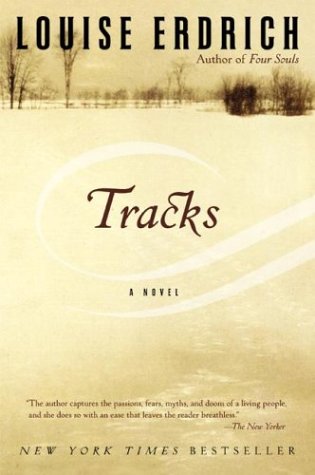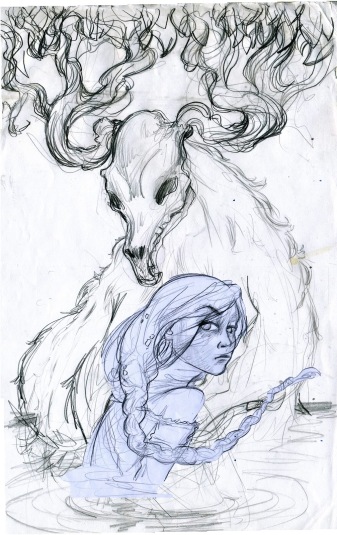I am pretty sure that some of you might recognize the name of the following author that I’ll make review of in the incoming texts, so I don’t think it is quite necessary to introduce a huge deal of her and her work.
However, just in case, and especially for those who don’t know her (as you’re the guys I’m specifically aiming to with my book reviews, as I want to spread as much as possible the word of these authors) and if you’re feeling quite lazy of clicking on the Wikipedia link, I will make just a brief description of her and what she has written so far, so you can have an idea of what’s coming…
…And what’s NOT coming.
Louise Erdrich.

Erdrich is a living Ojibwe author of European roots, nowdays stationed in the reservation of North Dakota, the Turtle Mountain Band of Chippewa Indians, and one of the most significant authors of the called second wave of the Native American Renaissance, which is, as you may guess, a way to refer to the considerable literary production done by Native Americans. Erdrich has won several prestigious awards, and currently owns an independent bookstore as well, called Birchbark Books, whose online store you can find it here and actually discover some neat titles on the list. You should check it out; it’s quite cool and got lots of Native American titles.
Erdrich has written, naturally, of the Native American’s present, not just about the past as usually a Hollywood screenwriter would. She actually captures with amazing style the life of contemporary Indian reservations and pours lots of mysticism and Native style on her works. Her most known and famous one is the Native American series, which include books like Love Medicine, The Last Report on the Miracles of Little No Horse, Bingo Palace, Tracks… I recommend you reading this series; I’ve read three of these titles and they’re sure worth your time. They’re informative, they’re magical, they’re not preachy, they’re mysterious… They’re humane. And that’s something no author can easily do in these Two Thousands, which is filled with marketing, commercialism, frivolous prose… Erdrich can sure make miracles at anything she touches and you usually don’t end up disappointed.
Usually.
See, I want to make a double review of two of her works, which comprise the best and the worst of her, which I had to meet in such an awful manner, to my chagrin. I would have loved to review my favourite ones—Love Medicine and The Last Report…—and transmit to you, O Reader, why I loved them. However, since it’s been quite a while ever since I read them, I will refer to the most recent readings I did of her and which are complete opposites. One’s the pleasant surprise; the other an AWFUL surprise respectively.
Tracks and Shadow Tag.
Let’s start with Tracks.
Tracks

This is one of the Native American series titles, and I consider it one of the weakest titles, but still, it’s a pretty good catch.
It is about one of the most recurring characters on the series, Fleur Pillager, and the mysterious things that happen around her and the mysterious entity she actually is. We follow her from the very moment she’s rescued by one of the narrators, Nanapush, when the blizzard destroys her whole family. We see two viewpoints of this character, coming from Nanapush, who’s the only one to understand the feared and dreaded Fleur’s mysteries, and another one coming from one of the most complex characters of the series, Pauline Puyat, who’ll eventually transform in the…quite crazy Sister Leopolda, a key character in Love Medicine and The Last Report…
The plot itself could sound almost boring, as it just deals with the weirdness happening around Fleur. However, it ends up becoming a great book thanks mostly to Erdrich’s poetic and mystical prose, which is one of the best points of this book. In fact, it’s the prose, the characters—very mysterious all of them and very endearing with their complex mindset—and the humane way in which the author deals with the Indian problem back in the beginning of the 20th century.

This is a fan-art-like illustration done by Chicago illustrator, Kathleen Joyce. Click on the drawing to direct to her own blog and check out her other works.
As I said, it is not preachy, so it’s quite easy to relate to the characters without feeling the demand to do it. You do get inside of their minds and their skin, and you can feel the way they deal with their world, which is slowly crumbling apart because of the gradual intervention of non-Indians and even Fleur’s almost diabolical presence.
There’s rarely a long piece of dialogue, and most of the prose focuses on the descriptions of the weird events and the “oral” tradition-like way of exposing them, to make them sound as rumours. Rumours that, of course, the reader can choose to take them as such, or even as mere hallucinations created by the slowly degrading people who bump into Fleur. Or even coincidences. Frankly, who knows? Nobody knows in the end what’s going on, and that’s the best thing of the book: the reader in the end’s the one with the final answer, and the one living through these characters the experience of seeing one’s culture tearing apart in a very harsh moment of their history.
The only flaw I see in this book is that it might not be very well appreciated if you don’t read first the other novels of the series. I appreciated it mostly because I knew of whom was the author talking about, and I actually picked it up because I wanted to dive more into Fleur and Pauline, but then, as the lecture progressed, I became aware that this book, as a standalone, might have some problems. It wouldn’t erase any of the beauty the author crafted, but I say and take it as a warning that you might love this book mostly if you read first previous works from the author, just in case, because too many names and too many references will only make sense if you do. So yeah, I don’t recommend this book if you don’t have any idea of what’s behind these characters, which is actually exposed in Love Medicine, Erdrich’s debut novel. So I recommend, for the maximum pleasure, diving just a bit into deeper water before walking to the shore.
Now, onto a harder piece…
Shadow Tag

I’ll be honest. I’ll be completely honest, O Reader. I am surprised of this book, and not in a good way. In fact, I still can’t believe it was written by Louise Erdrich. Not only is her enriching and poetic prose absent in this book: her craft in her characters is also gone in here.
The story is as follows: Irene America’s the alcoholic wife of a prominent local painter, Gil, who tends to use her as a model for his work. She’s got a red diary, and one day she discovers Gil’s been reading it secretly, and as revenge, she starts writing lies and malicious things on it so she can write a more “honest” one in a blue notebook. Naturally, she writes disturbing and shocking stuff to Gil, who slowly starts becoming quite desperate when he starts suspecting of his wife’s love. He tries to desperately win her back, but for no real reason specified, Irene keeps torturing him. You get the idea she’s trying to get her revenge, but as the novel progresses, you start wondering if she’s mentally unstable or something…which is not what the author seemed to intend on her, at least on my opinion.
So in few words, this book’s just about a spiral of (unintended) madness. So, yeah.
Unlike her previous novels, specifically those of her Native American series, this book lacks an imaginative prose. It’s dull and gray, and walks in a rather tedious pace, even though it is fast paced as it was correctly pointed out in a review on the back cover. And unlike other reviewers whose scathing reviews I also read, I didn’t find the “grim” or “malicious” vibe on the book. In fact, I felt nothing. I didn’t find it grim: I found it boring.
Boring. Boring. Boring. Because the real stuff behind all the intensity and drama…is not there. It’s all so…shallow.
Unlike what the back-cover premise said, this book doesn’t have the promised diary drama that was remarked everywhere. In fact, I feel…scammed, to say the least, because this book had a nice concept and did seem to have a good point to land in… But no. Erdrich, for some mysterious reason, didn’t play with the very strong points she got in the idea and, instead, played on silly scenes that were supposed to be intense, violent and uneasy to deal with, and which in the end were…stiff and almost inhuman. You could say it is because of its very nature as a fast-paced novel, but still it’s no excuse. The House of the Sleeping Beauties of Yasunari Kawabata is a fast-paced novel (I finished it in four hours), and yet it got all the intensity of an anvil. Really!

That sensation you feel when a cartoonish anvil falls over you is the same you feel when you read Camus’ The Stranger and most of Dostoievski’s and Kawabata’s prose. So yeah, maybe all writers should begin their careers as smiths!
The diary plot was unused. I think there were only 10 entries in total, and none of them did an actual shocking moment to the plot. In fact, I think you could remove them and still the plot could have kept going, albeit even more boringly. Let’s face it: it was just some…odd fight between Irene America and Gil. We never find out why they were deteriorating as a couple in first place, and even though we do see their breaking apart, it feels…odd. Not forced, but it doesn’t have any sense, nor reason to exist. I still wonder what was wrong with Irene, and why she acted this way towards her husband, aside of that “reading my diary” excuse. Gil is perhaps the only a bit more realistic character and who acts more alike his personality. But Irene… Seriously, what’s wrong with her?
To resume it all, this book is disappointing. Or better said, the back cover, at least personally, disappointed me horribly. This is the second time the plot description has deceived me, but, unlike The Last Report of the Miracles at Little No Horse, this one really punched my gut. The characters are flat—the leads, by the way, show no reason or road to mistreat this way, so I still wonder how this book came to happen—, the best idea was unused, and… Was I the only one who disliked a lot the children? I dunno, I felt them…unreal, almost disgusting, almost parodies of the actual nature of real children. It’s not the first time I’ve read porcelain children like these ones, but it surprises me, coming from Erdrich, whom I always considered an almost almighty author…
I guess I committed the mistake of liking her a lot, huh.
So these are the reviews. The best and the worst of Erdrich. And still, I recommend her a lot. Not Shadow Tag, but do know her first through the Native American series and, maybe (haven’t read it completely, but the first 20 pages did catch my attention), The Master Butcher’s Singing Club (if you’ve read it, feel free to comment on this article your recommendation). Those do contain Erdrich’s wondrous signatures and her vivid talent.
After Shadow Tag, though, I came to a concise conclusion towards Erdrich’s novels, especially the ones that promise a lot in their book covers. And take this as a heart-to-heart advice, O Reader: read their first 50 pages before you buy them. Read them consciously and without any discrimination nor obsession. Just read, and if the story comes to you as in Love Medicine, Tracks and The Last Report..., then it is worth your time.
Because after I read 50 pages of Shadow Tag, I realized I committed a great mistake in buying it.

Thanks for reading!
Please, do comment! All other recommendations of Louise Erdrich’s books are welcome.
[All images redirect to their original sources]
Tags: Albert Camus, Book review, Fyodor Dostoievski, Literature, Louise Erdrich, Love Medicine, Native American, Ojibwe, Shadow Tag, The Last Report on the Miracles at Little No Horse, Tracks, Yasunari Kawabata

















